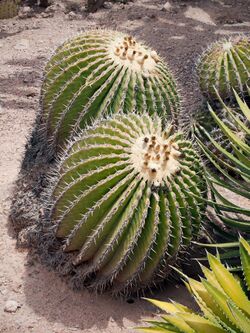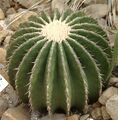Biology:Echinocactus platyacanthus
| Echinocactus platyacanthus | |
|---|---|

| |
| Scientific classification | |
| Kingdom: | Plantae |
| Clade: | Tracheophytes |
| Clade: | Angiosperms |
| Clade: | Eudicots |
| Order: | Caryophyllales |
| Family: | Cactaceae |
| Subfamily: | Cactoideae |
| Genus: | Echinocactus |
| Species: | E. platyacanthus
|
| Binomial name | |
| Echinocactus platyacanthus Link & Otto
| |
Echinocactus platyacanthus, also known as the giant barrel cactus, golden barrel cactus, giant viznaga, or biznaga de dulce,[2] Its Nahuatl (Aztec) name is Huitzli nahual. It is a species of cactus (family Cactaceae). It is native to central Mexico in the Chihuahuan Desert.[1] This species is the largest of the barrel cacti. In Mexico the hairs are often used for weaving; the acitrón, a traditional Mexican candy, is produced by boiling the pith.
Description
This slow-growing species can reach sizes up to 2.5 m (8.2 ft) tall and 1.5 m (4.9 ft) wide and can live over a hundred years. Photographs exist of specimens almost four feet (almost 1.2 m) in thickness.[3] What is probably the largest individual living today is the one called "Goliat" at the "Area natural de Daxpe" in the municipio de Cadereyta, Querétaro State, Mexico, which is 9' 8" (2.95 meters) in height, at least three feet (0.9 meter) thick and weighs about three metric tons (6,600 pounds).[4] Another at Ixmiquilpan, Mexico has a measured diameter of 3 ft 11 in (120 cm) and is 7 ft 10 in (2.4 meters) high.[5] Britton and Rose reported a specimen (with photograph) which was 1.33 meters (4 ft 1in) thick, by ten feet (three meters) in height and weighed 4,400 pounds (2,000 kilograms).[6] Their stems are a gray-ish blue color and the straight, rigid spines are black. The apex of the cactus is flat and covered with a yellow felt-like substance. They are heavily ribbed, with 25 to 30 vertical ribs, and have large areoles. Their diurnal, tubular flowers bloom at the end of spring to summer and are a vivid yellow color; they grow to about 2 cm (0.79 in) in height and 3 cm (1.2 in) in width.[7] The fruit is about 3 cm (1.2 in) long and is covered by a hairy wool.[8]
Gallery
References
- ↑ Jump up to: 1.0 1.1 Hernández, H.M.; Cházaro, M.; Gómez-Hinostrosa, C. (2017). "Echinocactus platyacanthus". IUCN Red List of Threatened Species 2017: e.T152537A121477917. doi:10.2305/IUCN.UK.2017-3.RLTS.T152537A121477917.en. https://www.iucnredlist.org/species/152537/121477917. Retrieved 11 November 2021.
- ↑ "Giant Barrel Cactus, Biznaga Gigante Echinocactus platyacanthus". Dave's Garden. http://davesgarden.com/guides/pf/go/59905/.
- ↑ "Photographic image" (JPG). https://s3.amazonaws.com/siteninja/multitenant/images/18793/images/medium/Echinocactus_platyacanthus_Oaxaca_DSC04272.jpg?1367857215.
- ↑ "Photographic image" (JPG). https://pbs.twimg.com/media/B-bBvY5CMAAsdEJ.jpg.
- ↑ Coulter, John M. (April 1, 1896). "Preliminary Revision of the No. American Species of Echinocactus, Cereus and Opuntia". Cotrib. to the United States Nat'l Herbarium 3 (7): 83 plus photo plate XVIII B.
- ↑ Britton, Nathaniel; Rose, Joseph (1963). Cactaceae - Volume III (reprint). New York: Dover Press. p. 170.
- ↑ "Echinocactus platyacanthus". CACTUS ART NURSERY. http://www.cactus-art.biz/schede/ECHINOCACTUS/Echinocactus_platyacanthus/Echinocactus_platyacanthus/Echinocactus_platyacanthus.htm.
- ↑ "Echinocactus ingens". Cactus Art. http://www.cactus-art.biz/schede/ECHINOCACTUS/Echinocactus_ingens/Echinocactus_ingens/Echinocactus_ingens.htm.
Wikidata ☰ Q239734 entry
 |







